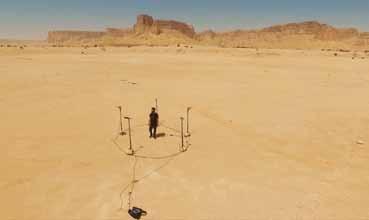
5 minute read
REVIEW Ithra
from Tribe 09
Ithra: Zamakan Eleven artists contemplate space and time through geometry, poetry and desert sounds
Zamakan is an unusual expression, combining the two Arabic words for time (zaman) and space (makan). Ithra invited 11 contemporary Saudi artists to construct artwork portraying their perspectives on the concepts of space and time.
Advertisement
According to Candida Pestana, the exhibition’s curator, “the artists were invited to reflect on these concepts from both a physical and a philosophical point of view, to explore distinctive spaces and dimensions in different times.”
The results were individual interpretations of ‘Zamakan,’ drawing upon rich cultural heritage as a unifying element. The exhibition showcases the artists’ different art forms as sculpture, video, photography and installations.
Contrary to the vastness of the ‘Zamakan’ theme, the exhibition draws from a specific space and time. It is made by Saudi and Saudi based artists and addresses a Saudi audience. “The artists talk about their space and their time. It’s their individual viewpoint, and they are addressing their community. We wanted to do an exhibition with concepts that are known to everyone, yet everyone has a different notion about them,” said Pestana. One of the works that resonates most strongly is a massive installation by Maha Malluh, entitled Oil Candies, consisting of crushed oil barrels, each brightly coloured and attached in rows to the wall. It’s a reflection on the effects oil has had on Saudi Arabia. Here we see Malluh doing what she does best, arranging an installation to draw the viewer in and make them feel part of the work. She contemplates the power of oil and its effect on every aspect of Saudi life.
Pestana sees Oil Candies as a “homage to the Kingdom and the changes brought by oil.” She discerns yet more meaning in the sheer size of the installation; some 74 oil barrels displayed across a 10 X 4 meters wall to represent “the enormous impact of oil on the country,” said Pestana, adding that the crushed barrels, which resemble discarded candy wrappers, represent “the sugar rush you get from candy,” or in this case, the “oil rush.” It has been a burst of energy infused into the country, but what happens when the rush is over?
In The Sound of the Desert, Abdullah Al-Othman portrays himself within the context of the vast, arid expanses of the country to reflect on the theme of the exhibition. His video performance shows him in the middle of the desert, surrounded by microphones, where the artist recorded a performance while listening to the sounds around him at different times and from five different angles. It is that sound change and variation that
Al-Othman wants the viewer to perceive. The desert also inspired Ayman Zedani in his work The Sailing Stone, which depicts a Saudi ecological journey through the natural phenomenon of rocks inscribing long tracks on the valley floor without human or animal intervention.
In this artwork, the artist uses agate stone, which is local to Saudi Arabia, to mark traces on a mould. Pestana explains that “each stone is different and each trace is different. What he is talking about is ecological communities. From a wider perspective, all stones look the same, but when you get closer, you will be astounded at how singular and unique each stone is.” Pestana sees in The Sailing Stone, the artist’s intent in “exploring how individuality can be perceived in different ways; it just depends on your perspective.”
Ahmad Angawi works with geometry. While studying at the Prince’s School for Traditional Arts in London, he acquired and honed his skills of traditional woodcutting, and in this exhibition, he puts his learning to good use by illustrating the power of geometrical shapes. Flow #2 arranges transparent PVC tubes in a pattern that reflects the geometry of the space.
Gallery View: (left): Maha Malluh Oil Candies (2019) Variable dimensions Center: Dana
Awartani Love is my Law, Love is my Faith (2016) Embroidery on silk, 200 x 200 cm
Gallery View: Omar Abduljawad Thuluth (2018) Sandstone, painted steel tube, paint on
laser etched acrylic and programmable LED strips, 333.6 x 333.6 x 333.3 cm

Dana Awartani delves into the world of words of interpreting eight love poems by Ibn Arabi, a 12th-century mystic, poet and philosopher whose verses of divine love were inspired by his visit to Makkah and encapsulated his feelings when standing in front of the Kaaba. Awartani elucidates Ibn Arabi’s compounded sense of fear and love that filled him as he looked at that sacred cube, standing as an intermediary between the human and the divine.
Awartani’s interpretation of the poems is both mystical and thought-provoking. She went to India to seek out traditional embroiderers. Her screens were handmade there, with patterns that reflect Awartani’s love of geometrical shapes and combinations. The screens are hung in rows to form a perfect cube and, by standing in front of them, the viewer is drawn into a meditative state, a search for their inner spirit.

Each of the 11 works tries, in its own way, to construe the space and time factors through personal viewpoints. Some manage to mesmerise the viewer and connect with them through the visual beauty of composition and material. Others take their viewer on an abstract journey, leaving them to find their own way through intricate and symbolic messages.
Zamakan is showing until October 26 at King Abdulaziz Center for World Culture (Ithra), Dhahran, Saudi Arabia.
Moath Alofi, I am One (2019) Digital print on Photo Rag, 200 x 140 cm
The Family (2019) Digital print on Photo Rag, 200 cm x 140 cm
The Scene (2019) Digital print on Photo Rag, 200 cm x 130 cm



Aziz Jamal Play, (2019) Video loop









Abdullah Al-Othman, Sound of the Desert, (2018) Sound and video installation, 8:20 minutes













